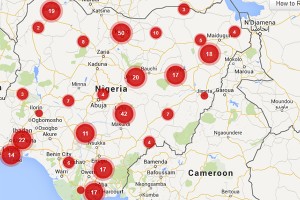The devastation caused by Tropical Cyclone Pam in the Pacific in March is a fresh reminder of the importance of early warning and emergency alert systems
Although the cyclone is regarded as one of the worst in the region in recent times, there were a relatively small number of casualties. This has been partly attributed to an SMS alert system that was quickly put in place as the cyclone started to form. It gave people time to evacuate to safer areas and seek more robust shelter.
Some disasters, such as the massive earthquake that hit Nepal at the end of April, can be predicted, but not to the degree that decisive event warnings can be issued. Nevertheless the importance of public communications in the wake of the tremors, which have killed over 6,000 people, cannot be overstated. Public broadcaster Radio Nepal has been praised over social media for staying on air with live updates, and helping to dispel inaccurate rumours about aftershocks on platforms such as Twitter.
Functional alert systems are at the mercy of cooperation between broadcasters, governments, telcos, NGOs and other countries, and they need to be free. Here’s how some countries and regions have fared:
Vanuatu
The archipelago of 65 inhabited islands in the South Pacific presents clear need – and challenges – for an emergency alert system. During the Cyclone Pam crisis, the public broadcaster’s transmissions were only reaching some of the islands, furthermore, the cyclone would go on to damage the country’s shortwave transmitters. For the first time ever, the government agreed with the two national mobile networks to send SMS alerts with condensed information on the location of the cyclone, first every three hours, then hourly as the cyclone neared. Kiery Manassah, a spokesman from the Vanuatu prime minister’s office visited one of the most southerly islands, Tanna, in the aftermath. He had asked people there how they received information, “they said that they got the information from the SMS alerts,” he told Radio Australia. “I would estimate that almost 80-90% of people have access to mobile phones,” Manassah added. Listen to the ABC Radio Australia interview
Canada
As of 31 March this year, Canada’s broadcast regulator requires all stations – public and private, cable and satellite companies, and even video-on-demand services to have the capacity to issue emergency alerts to regional audiences.Public broadcaster CBC Radio-Canada stated that although the service, called AlertReady, was a condition of their broadcasting licence “we view it as part of the public service we are proud to offer Canadians… and we are better positioned than most of the other broadcasters because we are so entrenched in the regions.” The system, which aims to warn of imminent events such as tornadoes, landslides and wild fires, has had a long gestation. Distribution of messages has been centralised since 2010 (by a company called Pelmorex). But voluntary takeup of this source by broadcasters and providers has proved patchy, so the regulator has made it mandatory. Some companies have been given 6-12 months extra to comply. Some have cited technical barriers such as the difficulty in interrupting broadcasts on older distribution platforms.
Nigeria
 Emergency alert systems are not only for natural disasters. A Kenyan not-for-profit software company has been at the forefront of mapping conflict and violence around the world, and their systems were used to develop the Nigerian Election Early Warning System (screengrab pictured) for the recent 2015 presidential elections. During the 2011 elections, where violence killed an estimated 800 people, a beta version of the system was trialled in the Niger Delta. The company, Ushahidi, has a platform called Crisis.net, which scans local news and social media reports, media reports from the News Agency of Nigeria, as well as crowd-sourcing data from citizens, and citizen journalists. Citizens were encouraged to report incidents, such as hate speech, attacks on rallies and voter intimidation, which are then mapped. People can sign up for alerts. The system was spearheaded by an international NGO, Search for Common Ground, working with TMG, a civil society-based election monitoring group. The organisations aimed to “share [the information] with key stakeholders with the ability to formulate an early response to prevent violence.”
Emergency alert systems are not only for natural disasters. A Kenyan not-for-profit software company has been at the forefront of mapping conflict and violence around the world, and their systems were used to develop the Nigerian Election Early Warning System (screengrab pictured) for the recent 2015 presidential elections. During the 2011 elections, where violence killed an estimated 800 people, a beta version of the system was trialled in the Niger Delta. The company, Ushahidi, has a platform called Crisis.net, which scans local news and social media reports, media reports from the News Agency of Nigeria, as well as crowd-sourcing data from citizens, and citizen journalists. Citizens were encouraged to report incidents, such as hate speech, attacks on rallies and voter intimidation, which are then mapped. People can sign up for alerts. The system was spearheaded by an international NGO, Search for Common Ground, working with TMG, a civil society-based election monitoring group. The organisations aimed to “share [the information] with key stakeholders with the ability to formulate an early response to prevent violence.”
Caribbean
The success of alert systems rests on their testing, and the majority of the Caribbean countries, as well as adjacent parts of North and South America, take part in an annual tsunami warning drill. It is led by Unesco, the US National Tsunami Warning Center and the Pacific Tsunami Warning Center, and involves dozens of countries and tens of thousands of people. Unesco urged: “Experience has shown that timely dissemination of information is crucial.” Every March new scenarios are tested, and this year they were the simulation of a tsunami from a magnitude 8.5 earthquake in the sea north of Panama, and another off the coast of Florida, USA. Fake test alert messages were sent out by the warning centres, and then disseminated by broadcasters and agencies in the different countries. Messages were sent by just about every conceivable means. For example, in the British Virgin Islands, the public received alerts and messages via TV, mobile network providers, FM (including Radio Data System protocol) and marine radio, email, websites and social media – and of course, sirens. Read coverage by Ziz Online of St Kitts and Nevis on tsunami preparedness.
Related Posts
23rd December 2014
Welcome to the Public Media Alliance
5th November 2013
International broadcasters in the battle for influence
The contest between public media brands…

